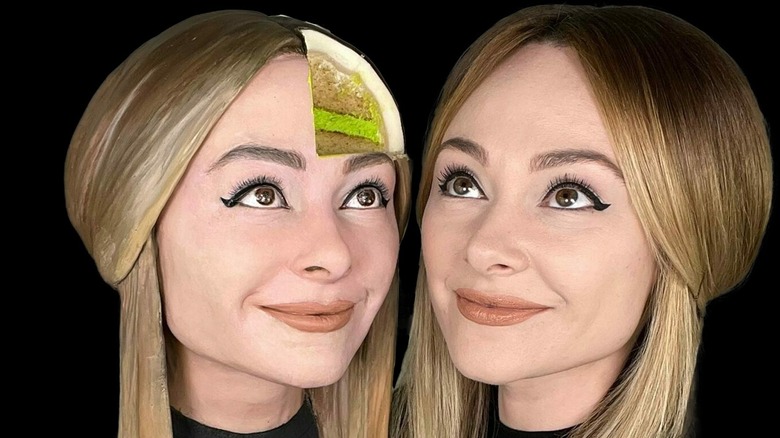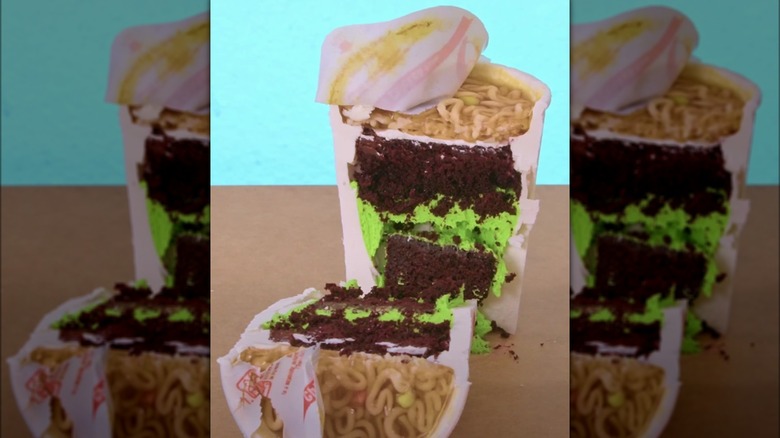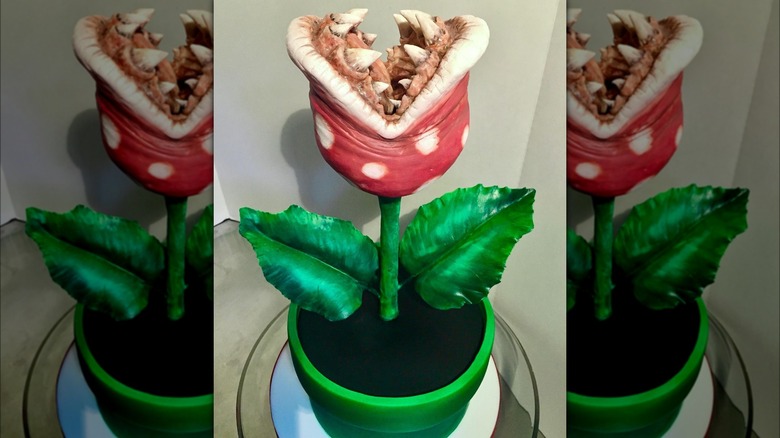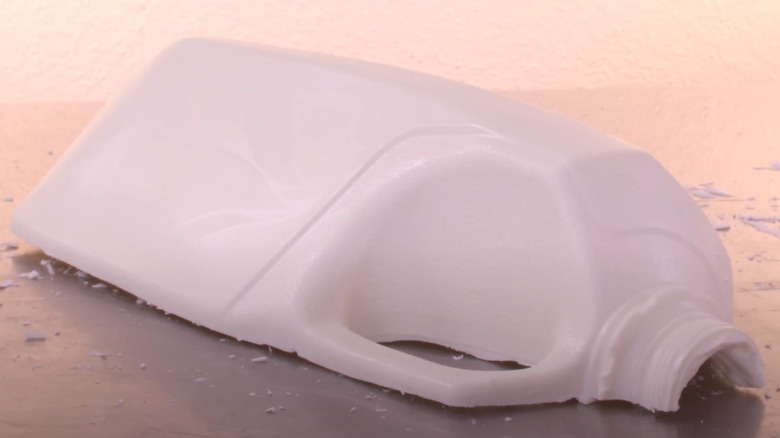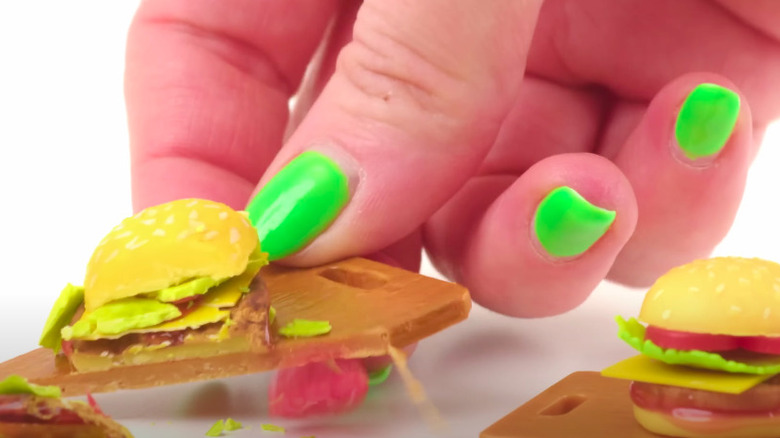What Natalie Sideserf Has Learned After Years Of Making Hyper-Realistic Cakes - Exclusive Interview
For many people, cake evokes feelings of joy, whether it's the perfect birthday cake or a simple nutty coffee cake. For Natalie Sideserf of Sideserf Cake Studio, it serves as inspiration for her artistic creations. Sideserf began her hyper-realistic cake-making journey in 2008, after graduating with a Bachelor of Fine Arts degree. Taking from her classical training, she uses edible materials to transform the popular dessert into a work of art. Following a viral bust cake of Willie Nelson in 2013, Sideserf has continued to blow up the hyper-realistic cake scene.
From cake-making competitions to opening a studio where she creates one-of-a-kind commissions for eager clients, Sideserf's work is in constant evolution. She showcases her latest cakes on her social media channels, along with plenty of tricks she learns along the way. In an exclusive interview with Tasting Table, Sideserf divulged her favorite parts of the process, what ingredients and tools she can't live without, and tips for making your own hyper-realistic creations if you're so inclined. Read on to learn all about her edible art and what's on the agenda for Sideserf Cake Studio this year.
Creating the cake from start to finish
What's your favorite part of the whole cake-making process, from the conception of the design to the actual creation?
Ooh, that's kind of a fun question because there are a couple of moments that I really like, and it depends on the cake. But the first thing I like is when I come up with an idea that I'm just really excited and passionate about. And when I say idea, it could be anything, like one of my examples is an onion where I used wafer paper. So I'm using this edible material to look like an onion skin. And so when I can pull that off, it's just really, really fun.
But what I'm going to call my second favorite part is when I cut the cake because it's this whole process. Everybody's always like, "Are you sad you cut it?" And I'm like, "No, I want to cut it. I want to move on." And I think that it's really fun and people really enjoy the cutting.
Yeah, it adds to the cake effect! What's the longest part of the process from the plan to the final production?
I'm going to say it's got to be just the sculpting, depending on, of course, what I'm making. If I'm hand sculpting something, if I make a cake of a person or something very detailed, I'm adding texture and everything, so that takes a lot of time. So, I have to kind of zone out and get into it. And I try my hardest to make it as accurate as possible so that eats up a lot of the time.
It looks like what it's supposed to look like, so that's understandable. You do a lot of commissions, but what are other sources of inspiration for your designs?
I'm always just kind of looking at things and in my head, I'm like, "Literally anything can be a cake." Everything has potential. So, even if I'm looking at the ceiling, I'll look at the fan and I'll be like, "How can I make a fan cake?" So, it's crazy how much I'm thinking about cake, but sometimes it just pops in my head.
Is there something on your mind lately that you'd like to try sometime soon?
You know what? I'm always kind of hopping around. I've got a list of things, ones that I want to make. I've actually been wanting to do another bust cake of a person because it's been a little while. I know that the most challenging cake that I make is when it's a person. So, I've been wanting to do that, I just know it's going to take a very long time, so I've got to set the time aside.
That makes sense, those are very cool! You fill your cakes with green buttercream to identify your videos with a signature. Have you noticed that it helps reduce the number of people ripping off your videos, or do you still deal with that?
It has helped. It's really cool because if I see somebody, like an account — even really big ones will share my work without crediting me — and I'll see in the comments, a lot of people will be like, "There's green in that, it's a Sideserf cake." And it makes me so happy, I'm like, "Oh, it's so cool that they know that's what that means," so it's pretty neat.
Dealing with unexpected obstacles in the process
Do you have any stories of big behind-the-scenes mishaps — something going wrong that you thought would work out?
I've been making cakes for so long that there's definitely been some. There's a lot of learning, I had to experiment a lot along the way. There have been moments where things did go wrong, but what I do is don't — it's a little bit cheesy — but I don't give up. If something goes wrong, I'm going to take a second, problem-solve, figure it out, and then make it work. So, I always try my best to find a way to make it work, and I don't even think there's a time when I completely gave up. There are just ways to adjust the design or even sometimes I've had to start over completely. But I don't know, I just never want to let it go.
Then it becomes more of a challenge to find the right approach.
Totally, and then that also allows me to learn. When I figure it out, it's like, "Now that I figured that out, I won't make that mistake again."
Does it often happen that partway through you realize you have to swap the materials or incorporate something else to make a design work?
That happens a lot, especially because lately I've been messing around with trying things where I don't have a set game plan because I want to be like, "Can I make this happen?" Off the top of my head, I'm not really sure if this is going to work, but I'm going to try my best. I feel like getting your hands on it is the most important thing. I need to physically do it, not just think about it. So, once I get my hands on there, I try my best to find a way to make them work. So, it happens a lot and I can kind of predict it a little bit now.
Experience helps! You share some cake remakes and fails on your social media channels. Do you sometimes test the cakes beforehand or is the video a first attempt?
That is my first attempt, definitely. I like to try it and then I'm like, "I'm documenting this." I wasn't always this way, I used to kind of hide when I made mistakes. But I've been doing it for so long that I actually like to share when I make mistakes now because it allows everybody to see me try to work it out. I'm not perfect. If you just see the end product, you go, "Oh, so cool," but when you watch me try to get there, I guess it encourages other people to try new things and also experiment. So, I really like that about the videos.
Tips for making hyper-realistic cakes at home
What tips do you have for beginner bakers who are curious about experimenting with hyper-realism?
My best tips are, honestly, a catalog of videos that I have on my YouTube channel. What's really neat is when you're watching me make a cake, this is just my take on a cake. So, it doesn't mean that it's the only way to make this particular cake. If you watch my videos and you're like, "She did it like this," it's not necessarily a strict step-by-step. I feel like it's a little bit more open.
So, if you try to do a technique that I do and you're having a hard time, think about it a little, and maybe there's another way to approach it in a way that I didn't, maybe it's even better than my approach. Some of the techniques that I used to use, I don't use anymore because I found easier and better ways to make things, so I think it's just keeping an open mind and just really, really trying your best to experiment.
Nice. And in all that, how much cake-eating is involved in your process?
I eat more cake than I probably should, but I also give out a lot of cakes, which is nice because pretty much everybody likes cake. Not a lot of people turn down cakes.
Did you grow up loving cake? Is that a big thing in your family?
You know what? Actually, no. I wasn't a huge dessert eater when I was younger. I was very much into art. The art side of it I've been doing forever, but the actual cake part was a little bit later. And it's funny now because now I have a sweet tooth, so I want to try desserts at like every restaurant. And I'm like, "Oh, I did this to myself. I should have known."
It grew on you.
It did.
What have you learned about transporting cakes? Do you have any tricks for the average person trying not to ruin a birthday cake?
It's very difficult, and I think that just having patience when you're driving, because people do get upset with you because you're going really slow, but it doesn't matter. You have to ignore them. You have to take those turns really slowly. Otherwise, they can topple over if they're not super secure, it's a whole thing. So, I would say be very cautious when you drive.
The elements that help the cake come together
What is your most used kitchen tool in all of the cake-making process?
That's a good question. What couldn't I live without? As far as a kitchen tool, I'm going to say I use a rolling pin a lot. And that's a lot of times because I cover my cakes in a product that I'm going to have come out soon, which is edible clay. It's a modeling chocolate, and what I do is I roll it out and then I place it on top of the cake and then I sculpt it. And if I wasn't able to have that rolling pin on hand — sometimes I even use it to sculpt and shape — if I didn't have that rolling pin, I probably wouldn't even be able to use the product, so I'm going to go rolling pin.
That's fair. Is there anything else you can share about the edible clay product you're releasing?
We're going to have it out soon — if you go to Sideserfcakes.com, we have a mailing list and if you sign up for that, we're going to let everybody know right when it's out. What's really cool about it is you can use this edible clay to make something as detailed and crazy as a hyper-realistic cake. I have plenty of examples of me using it on my YouTube channel, but it's also super friendly for kids to mess with. Kids could treat it more just like a regular clay — only you get to eat it, of course — but they mess with it, and it's very kid-friendly too, which is cool. You don't have to make something insanely detailed or anything, but it's nice to still play with if you're by yourself, or to do it with your kids and things like that. It's fun stuff.
You said it's basically chocolate and other things?
It's modeling chocolate. I call it edible clay because the texture and the way it sculpts is so similar to clay, and then of course the fact that you can eat it. But it's mostly chocolate, so you get that chocolate flavor, like a white chocolate.
Nice, do you think that's going to become your most used ingredient? I know the cake itself is probably pretty ubiquitous in your projects, but is there another ingredient to go with that?
If I were to pick three things that I use the most, it's going to be cake number one, and the green buttercream number two, but I couldn't make them look hyper-realistic without the edible clay.
Familiar and novel baking projects
What are some of your favorite cakes that you've made lately?
I've been always playing around with textures, and so any time there's a neat texture that I get to recreate, I have a lot of fun with that. Any time there's a high shine versus a matte in something that I'm making. I like that the two things are next to each other, and I get to do that a lot with products. Sometimes I'll make an edible plastic and it really looks like plastic. It's made of gelatin, but it's like a gelatin sheet. And that shininess next to maybe a packaging or maybe a cardboard that's got that matte texture. I just always have fun with textures.
Nice, especially from an artistic background, that follows.
It makes it more of an interesting finished cake, I think, and believable.
Are you curious about making any hyper-realistic food creations using different materials that aren't cake?
I have talked about doing that potentially down the road. I feel like at some point I might end up using ... I don't know if I would go back to traditional materials, or maybe something even crazy and unique that's out there, just like the cake. I'm not doing it quite yet, but it is definitely in my head.
Cool. You've been doing some mini-cake versions of objects. What have you found to be a challenge or advantage of that format?
I've made really, really large cakes. So, I've made a cake of a toilet for one of Mr. Beast's videos. It was a Willy Wonka video and they had me make a toilet cake and it was next to real toilets and it was a whole game ... and so when you make something really large and hyper-realistic, there's a lot that goes into it, but I wanted to do the opposite. I was like, "So, what if I made something really, really tiny, like a toy or something like that, and I try to replicate it super small, how hard would that be?"
And the bigger cake, I will say is more difficult, it takes more time, but it is really hard to make a tiny, tiny cake. I was surprised it's as difficult as it is. When you're working with these materials that melt, when you're working small scale ... it's like if you have a piece of chocolate — you have a chocolate bar in your hand, and then just a piece in the other hand — the small piece is going to melt with the heat from your hands and everything. So when you're working real tiny, it's a challenge but it's fun.
It's nice to try different things. Do you have any other plans for the coming year you'd like to share?
So, we just redid our website, which is really fun. That's sideserfcakes.com, and we also put out brand new merch. So, we have all these brand-new designs, and that was exciting. It was cool to come up with the designs with the designer and everything. I'm pretty excited about that product. We have the merch, the edible clay will be coming out soon, and then I have a few other things in the works, but I can't get into them quite yet until they're a little bit more finalized.
Follow Natalie and her hyper-realistic cakes on her website, YouTube channel, Instagram, or TikTok account.
